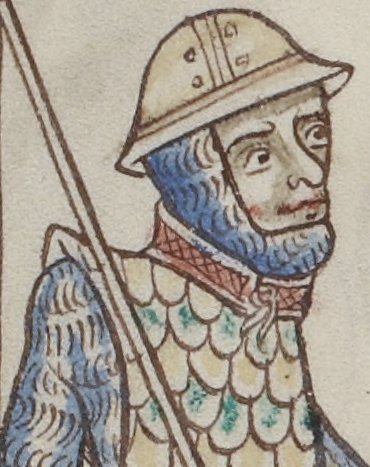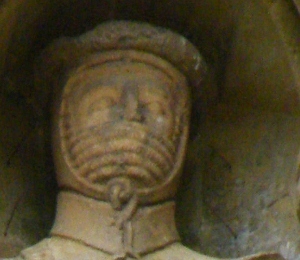Apart from padded protections wich go along with the gambeson, this one seems to be an early prototype of gorget. The dating is 1240, the statue is part of a group in the wells Cathedral.
What do you think about this? Are there other proofs of such an item in this century? In miniature or effigies?
http://www.themcs.org/armour/knights/Wells%20...%20631.JPG
A.
Looks to me like a typical soft, padded fabric collar that is seen throughout the Mac bible.
Mac bible, leaf 16, AD 1250
[ Linked Image ]
Mac bible, leaf 16, AD 1250
[ Linked Image ]
Could be hard, could be soft. Could be leather, metal, cloth or a combination. Could be organic plates sewn into a liner, could be mail. Could be lots of things but as long as its made out of period materials and period techniques and looks like the sources I'd have thought whatever works for you.
I know Blair is a little outdated, but...
Chapter 2: The Introduction of Plate Armour
"The last decade of the 13th Century also saw the introduction of a plate defence for the chin and neck (gorget* or brevor)."
"*Not to be confused with the later gorget or collar of which it was no doubt the precursor."
So my understanding is that the mail coif provided neck protection through the 12th Century. In the early- to mid-13th Century a padded collar was added (as seen the in the Mac Bible).
As stated above, the brevor followed the last decade of the 13th century. The gorget as we know it was not introduced until the 1430s:
"Before going on to discuss the arming of the limbs reference must be made to an important new piece of armour that seems to have been introduced in the 1430's: the collar or gorget. In its usual form this consists of two main plates, at front and rear respectively, enclosing the base of the neck and extending down over the top of the chest and back;..." [Blair, Chapter 4 The Great Period]
So the progression seems to be:
12th C: mail coif
13th C: mail coif > padded collar > brevor
15th C: gorget
Chapter 2: The Introduction of Plate Armour
"The last decade of the 13th Century also saw the introduction of a plate defence for the chin and neck (gorget* or brevor)."
"*Not to be confused with the later gorget or collar of which it was no doubt the precursor."
So my understanding is that the mail coif provided neck protection through the 12th Century. In the early- to mid-13th Century a padded collar was added (as seen the in the Mac Bible).
As stated above, the brevor followed the last decade of the 13th century. The gorget as we know it was not introduced until the 1430s:
"Before going on to discuss the arming of the limbs reference must be made to an important new piece of armour that seems to have been introduced in the 1430's: the collar or gorget. In its usual form this consists of two main plates, at front and rear respectively, enclosing the base of the neck and extending down over the top of the chest and back;..." [Blair, Chapter 4 The Great Period]
So the progression seems to be:
12th C: mail coif
13th C: mail coif > padded collar > brevor
15th C: gorget
A Casalucci,
I just found a book that says that the gorget in your photo in your post is whalebone. (Walker, History of Armour 1100-1700)
I just found a book that says that the gorget in your photo in your post is whalebone. (Walker, History of Armour 1100-1700)
That certainly sounds like pure speculation, given it's only a statue. Whalebone (baleen) as a material protecting the neck is given in this English translation of Guillaume le Breton's account of Bouvines, 1214 a.d., and the Latin copy I've seen supports its use. Still, it's a far leap to say that's what is being depicted on the Wells statuary with any certainty.
http://www.deremilitari.org/RESOURCES/SOURCES/bouvines3.htm
Phillipide, lines 696-7.
http://www.deremilitari.org/RESOURCES/SOURCES/bouvines3.htm
| Quote: |
| He says this but already his horse has felt his nerves slacken and can no longer stand. Then John of Condone and his brother Quenon run up to him and hit the count with many blows on each side of his head and throw down both horse and knight; they both fall head first, and then the count lies on his back, his thigh trapped and crushed under the full weight of the horse. While the two brothers busy themselves in binding the cavalier, John, nicknamed "de Rouvrai" (de Robore) ["strong"], a name which facts justify, appears and finally forces the count to surrender in spite of himself. And as he was slow in getting up from the ground, waiting in vain for help and still hoping to escape, a boy [a commoner] named Cornut, one of the servants of the Elect of Senlis, and walking ahead of the latter, a man strong in body, arrives holding a deadly knife in his right hand. He wanted to cut the count's noble parts by plunging the knife in at the place where the body armor is joined to the leggings, but the armor sowed into the leggings will not separate and open up to the knife, and thus Cornut's hopes are thwarted. However, he circles the count and looks for other ways to reach his goal. Pushing the two whalebones out of the way and soon pulling off the whole of his helmet, he inflicts a large wound upon his unprotected face. He was already getting ready to slit his throat; no one was holding him back and if it had been possible he would have killed him. The count, however, still resists him with one hand, and does his best to repulse death as long as he can. But, finally arriving at a full gallop, the Elect of Senlis pushes the threatening knife away from the count's throat and himself pushes away the arm of his servant. Having recognized him, the count cries: "Oh, kind Elect, do not let me be assassinated. Do not suffer me to be condemned to such an unjust death, so that this boy could rejoice to be the author of my destruction. The King's court would condemn me much better; let it inflict on me the punishment I have incurred." He says this and the Elect of Senlis answers him in these words: "You will not die, but why are you so slow to get up? Stand up, you must be presented to the King right away." |
Phillipide, lines 696-7.
| Quote: |
| Cornibus amotis balene et casside tota,
Ingenti faciem nudatam vulnere signât. |
Excellent reference Mart.
Harry, it leaves a lot of questions regarding construction, doesn't it? Possibly baleen inserted into sewn pockets, like later "boned" corsets, although now I'm the one speculating. It would explain the Maciejowski Bible's collar with horizontal stitching lines, but so would multiple layers of linen, padding, jaserant style defenses of fabric covered mail, etc. The Wells Cathedral example certainly looks rigid, but is it baleen, leather, or something else?
Very good questions.
I happened to be researching neck protection this week and am still looking through the references. I saw mention of whalebone armor in some books but nothing in enough detail to help me to understand why they used whalebone or why whalebone was so special. Which bone(s)? I keep imagining a vertebraebody hollowed out and cut in half for a gorget....
As for the neck protection on the Wells Cathedral effigy, I keep thinking that the method of closure is somehow key to figuring out its construction. For instance, the Mac bible neck protection is closed by what looks like toggles. This means its either fabric or leather. The Wells cathedral effigy gorget is closed by a frontal tie? What does that suggest?
I happened to be researching neck protection this week and am still looking through the references. I saw mention of whalebone armor in some books but nothing in enough detail to help me to understand why they used whalebone or why whalebone was so special. Which bone(s)? I keep imagining a vertebraebody hollowed out and cut in half for a gorget....
As for the neck protection on the Wells Cathedral effigy, I keep thinking that the method of closure is somehow key to figuring out its construction. For instance, the Mac bible neck protection is closed by what looks like toggles. This means its either fabric or leather. The Wells cathedral effigy gorget is closed by a frontal tie? What does that suggest?
Whalebone almost always refers to baleen, the keratin "teeth" of filter feeding whales. It's an interesting material like horn or plastic, with modern whaling laws limiting access. I've seen specific medieval European references to baleen being used as tournament swords, and in gorgets, gauntlets, and vambraces. It was also used in the Pacific Northwest by natives for armor.
http://en.wikipedia.org/wiki/Baleen
http://en.wikipedia.org/wiki/Baleen
A few examples from an English Apocalypse of c.1250, BNF Fr. 403.
http://gallica.bnf.fr/ark:/12148/btv1b8447298r/f10.item
http://gallica.bnf.fr/ark:/12148/btv1b8447298r/f55.item
We see examples in both a cross-hatched brown, and patterned green. These seem to lace in the front like the Wells Cathedral example.
 Attachment: 50.92 KB
Attachment: 50.92 KB

 Attachment: 89.75 KB
Attachment: 89.75 KB

 Attachment: 71.9 KB
Attachment: 71.9 KB

http://gallica.bnf.fr/ark:/12148/btv1b8447298r/f10.item
http://gallica.bnf.fr/ark:/12148/btv1b8447298r/f55.item
We see examples in both a cross-hatched brown, and patterned green. These seem to lace in the front like the Wells Cathedral example.



All of the various types of neck protection could be made rigid - even layered cloth and mail. There are tons of mail collars made rigid from dense weaves or reinforced with leather banding. The only real discussion should be working out the best way to replicate the neck guards depicted in various illustrations.
The second manuscript example has one collar which matches the depiction of the belt. It certainly leads to speculation that one possibility is leather. The white edging (also seen on the green collar) might indicate a fabric lining and edging.
It could also be heavily quilted cloth with a strip of leather added on top for decorative reasons.
Page 1 of 1
You cannot post new topics in this forumYou cannot reply to topics in this forum
You cannot edit your posts in this forum
You cannot delete your posts in this forum
You cannot vote in polls in this forum
You cannot attach files in this forum
You can download files in this forum
All contents © Copyright 2003-2006 myArmoury.com — All rights reserved
Discussion forums powered by phpBB © The phpBB Group
Switch to the Full-featured Version of the forum
Discussion forums powered by phpBB © The phpBB Group
Switch to the Full-featured Version of the forum